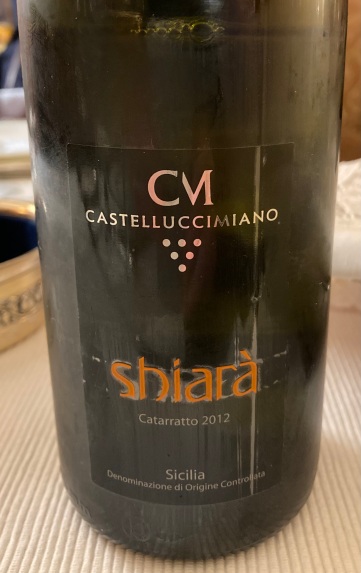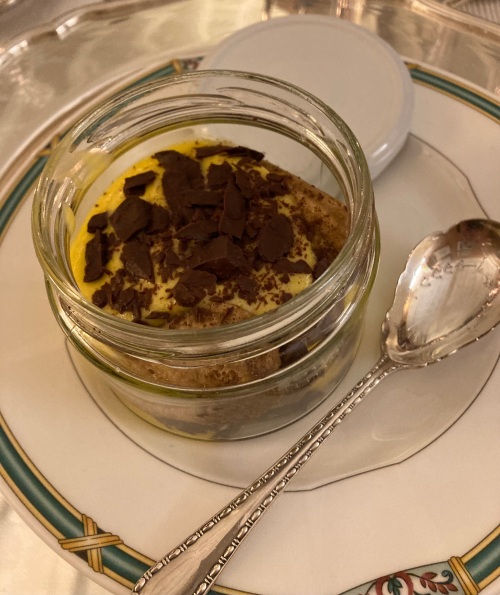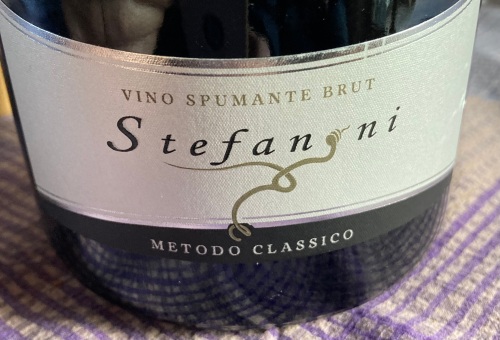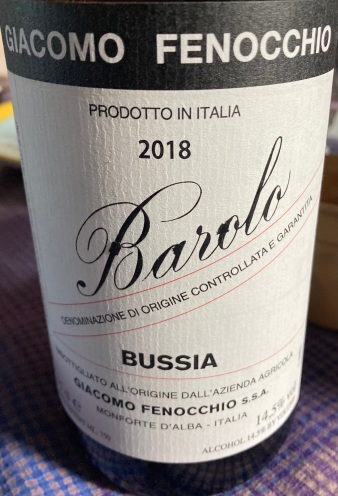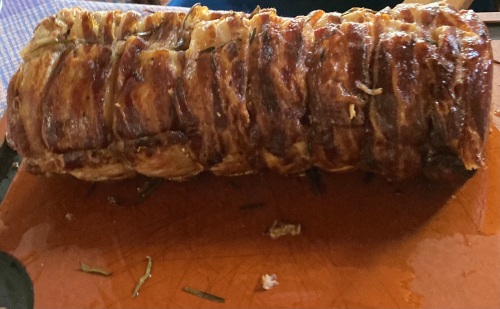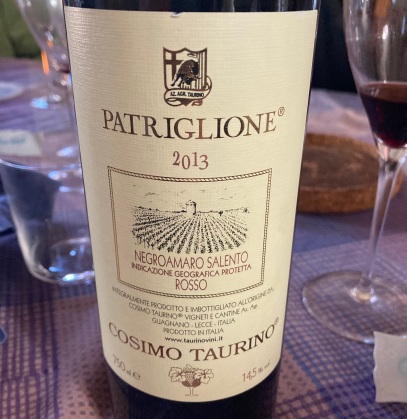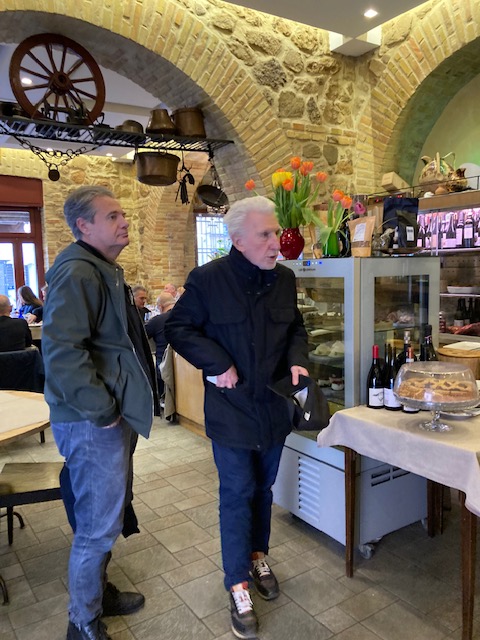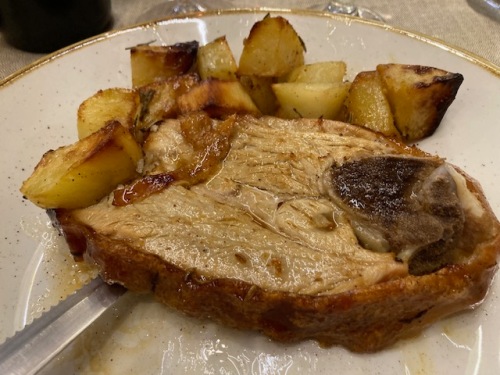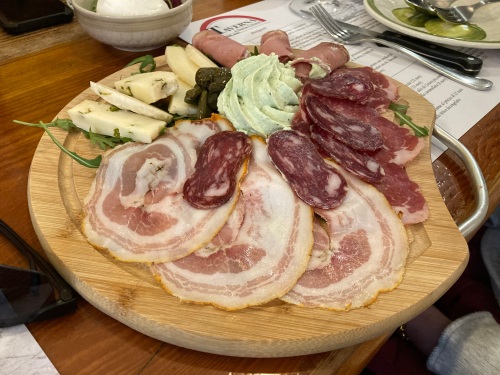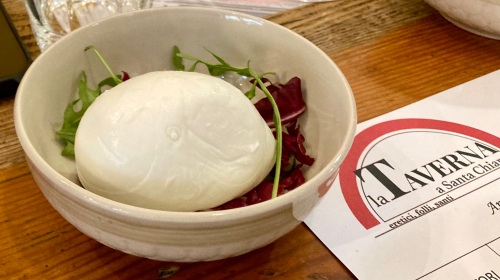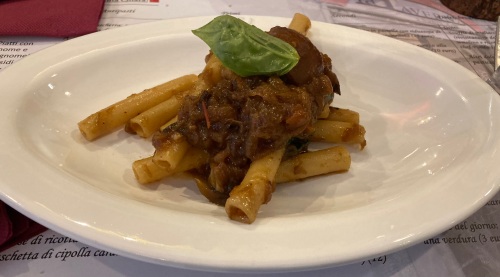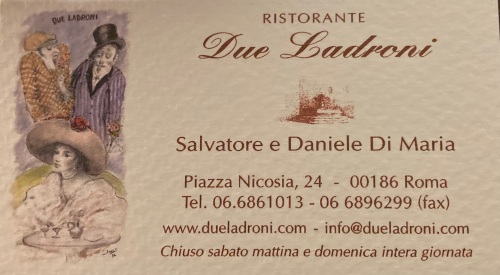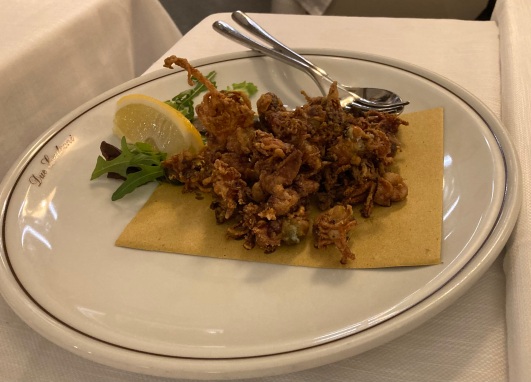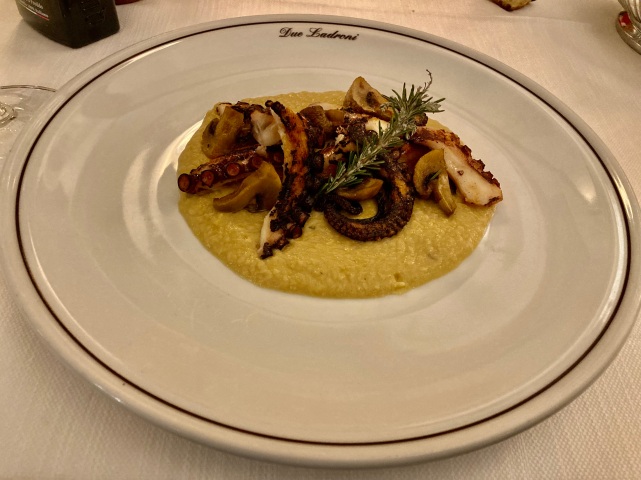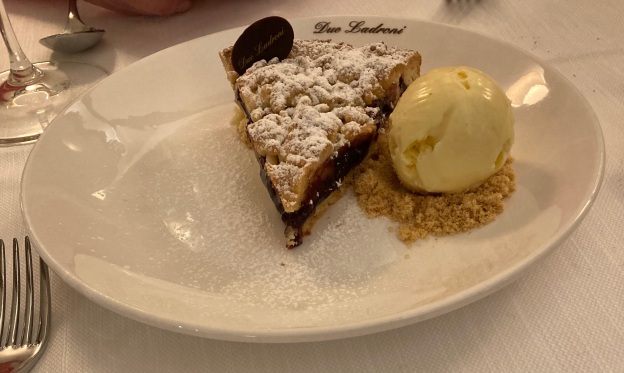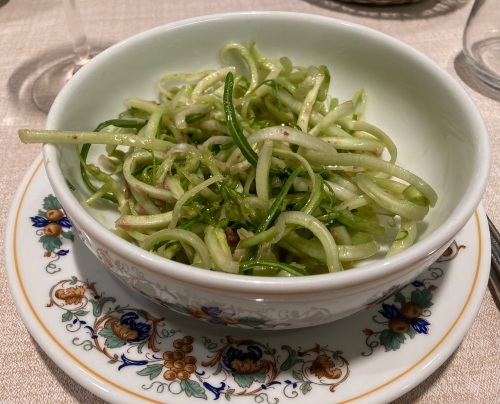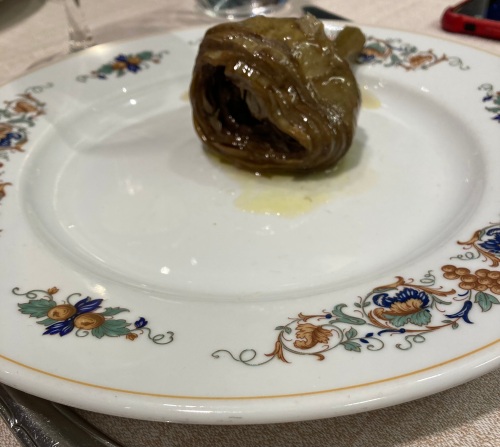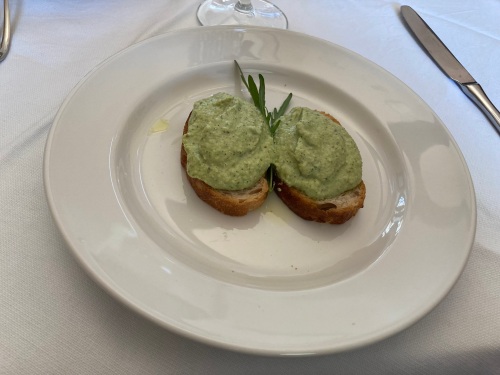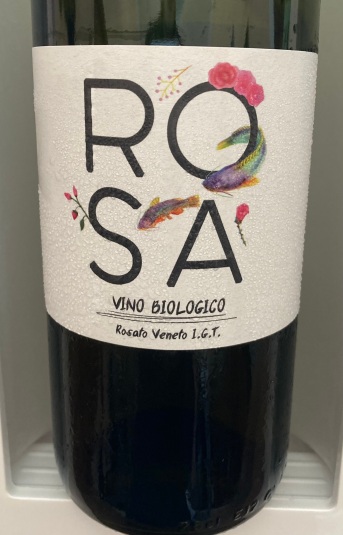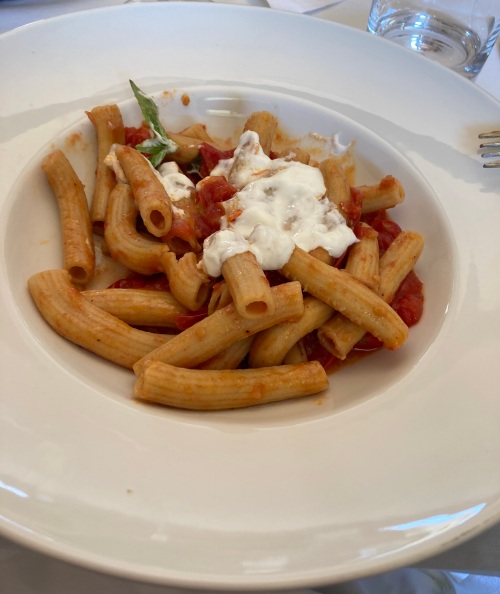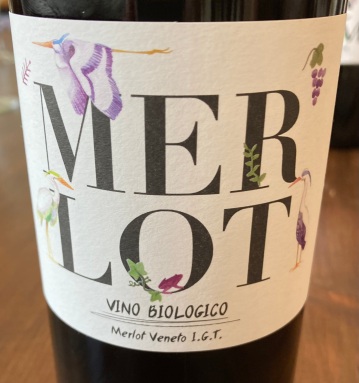Federica Schir (federica@federicaschir-pr.com) organized a wine tasting and dinner when I was in Rome recently with wines from four wineries. Last week I reported on the wines of Tenuta Rottensteiner with Hannes Rottensteiner. Here is my report on the wines of Càduferrà, represented by Davide Zoppi and his husband, Giuseppe Luciano Aieta.
Davide and Giuseppi
 The Càduferrà Winery started more than 30 years ago when Antonio Zoppi, originally from Bonassolo met and married Aida Forgione from Campania. Aida, named for the opera by Giuseppe Verdi, is a winemaker and the young couple decided to quit their jobs and move to Bonassolo on the Ligurian Coast and produce wine. Over the years they bought farmhouses and land in the surrounding area, including the Cinque Terre, and began to plant vines. In 2000, they named their winery Càduferrà, a dialect expression meaning “blacksmith’s house” because the rows of vines now cover an area where horses were shoed in the past.
The Càduferrà Winery started more than 30 years ago when Antonio Zoppi, originally from Bonassolo met and married Aida Forgione from Campania. Aida, named for the opera by Giuseppe Verdi, is a winemaker and the young couple decided to quit their jobs and move to Bonassolo on the Ligurian Coast and produce wine. Over the years they bought farmhouses and land in the surrounding area, including the Cinque Terre, and began to plant vines. In 2000, they named their winery Càduferrà, a dialect expression meaning “blacksmith’s house” because the rows of vines now cover an area where horses were shoed in the past.
 Davide, their son, and Giuseppe recently joined his parents in operating the property. Their plan is to look toward the future with an eye on the past. Together they turned the property into an agriturismo or holiday farm to attract tourism and modernized the winery.
Davide, their son, and Giuseppe recently joined his parents in operating the property. Their plan is to look toward the future with an eye on the past. Together they turned the property into an agriturismo or holiday farm to attract tourism and modernized the winery.
Davide said their pride is the recovery of rare and ancient vines as a way of returning to the past and respecting the place as it originally was. To rediscover the original viticultural crops, in its Bonassola soils, they aim to bring back varieties such as Ruzzese, Rossese Bianco, Picabon and Albarola Kihlgren, which have been present in the Cinque Terre and the eastern coast of Liguria since ancient times, but have been partially forgotten throughout recent history.
Càduferrà is located between the Golfo deli Poeti and the Gulf del Tigullio, 35 km from La Spezia and 50 km from Genoa.
The Vines and Wines
There are 4.5 seaside hectares divided into 11 tiny vineyard sites and crus. The vine rows are pergola trained and look out on the sea. Unlike most other wineries, all of the vineyards are multi-varietal with the white Albarolo, Vermentino and Bosco grown together and the red Sangiovese, Merlot, Ciliegiolo, Syrah and Granaccia as well as the rare Vermentino Nero grown together. The vineyards are certified organic and the oenologist is internationally reknowned Graziana Grassini.
 Colline Di Levanto Bianco DOP “Bonazolae” 2002 made from Vermentino, Albarola and Bosco grown on the Bonassola hills on the Ligurian coast. Some of the soil is rich in clay, of medium texture and some soil is lean and rich in sandstone skelton. After a short skin maceration the must obtained from the direct pressing of the grapes is decanted and only the limpid part ferments in temperature controlled stainless steel tanks. The wine remains on the lees with repeated bâtonnage. The new wine is bottled before the Easter holidays the year after the harvest. The wine has hints of jasmine, citrus, tropical fruit and floral notes.
Colline Di Levanto Bianco DOP “Bonazolae” 2002 made from Vermentino, Albarola and Bosco grown on the Bonassola hills on the Ligurian coast. Some of the soil is rich in clay, of medium texture and some soil is lean and rich in sandstone skelton. After a short skin maceration the must obtained from the direct pressing of the grapes is decanted and only the limpid part ferments in temperature controlled stainless steel tanks. The wine remains on the lees with repeated bâtonnage. The new wine is bottled before the Easter holidays the year after the harvest. The wine has hints of jasmine, citrus, tropical fruit and floral notes.
 Colline di Levanto Vermentino 2022 “Luccicante” made from 100% Vermentino. Various and characteristic soils with a clay composition, medium textured, originating from the tectonic uplift of marine terraces. After a short skin maceration the must obtained from the direct pressing of the grapes is decanted and only the limpid part ferments in temperature controlled stainless steel tanks. The wine remains on the lees with repeated bâtonnage The new wine is bottled before the Easter holidays, the year after the harvest. The wine has hits of chamomile, white peaches, apples, white flowers, almonds and citrus notes.
Colline di Levanto Vermentino 2022 “Luccicante” made from 100% Vermentino. Various and characteristic soils with a clay composition, medium textured, originating from the tectonic uplift of marine terraces. After a short skin maceration the must obtained from the direct pressing of the grapes is decanted and only the limpid part ferments in temperature controlled stainless steel tanks. The wine remains on the lees with repeated bâtonnage The new wine is bottled before the Easter holidays, the year after the harvest. The wine has hits of chamomile, white peaches, apples, white flowers, almonds and citrus notes.
 Liguria di Levante DOP Magia di Rosa 2022 made from Sangiovese, Vermentino and Syrah. The soil is various and characteristic, mostly clayey with a medium mixture. After a short maceration, the must obtained from direct pressing of the grapes is decanted, only the limpid part ferments in temperature controlled stainless steel tanks. The new wine is bottled before the Easter holidays, the year after the harvest. The wine has hints of strawberry, raspberry, white peach and a hint of jasmine.
Liguria di Levante DOP Magia di Rosa 2022 made from Sangiovese, Vermentino and Syrah. The soil is various and characteristic, mostly clayey with a medium mixture. After a short maceration, the must obtained from direct pressing of the grapes is decanted, only the limpid part ferments in temperature controlled stainless steel tanks. The new wine is bottled before the Easter holidays, the year after the harvest. The wine has hints of strawberry, raspberry, white peach and a hint of jasmine.
 Colline Di Levanto Rosso “ ‘Ngilù” 2022 made from Sangiovese, Ciliegiolo, Merlot, Grenache, Vermentino Nero and Syrah. Soil is various and characteristic, mostly clay with a medium mixture. Alcoholic fermentation in stainless steel tanks at a controlled temperature. After removing the must from the wine, the fermentation process continues in the same stainless steel vats. The wine is aged in stainless steel vats for a minimum of 6 months. The wine has hints of pomegranate, raspberry. red cherry and a hint of strawberry. This is the first time I have tried a wine with Vermentino Nero!
Colline Di Levanto Rosso “ ‘Ngilù” 2022 made from Sangiovese, Ciliegiolo, Merlot, Grenache, Vermentino Nero and Syrah. Soil is various and characteristic, mostly clay with a medium mixture. Alcoholic fermentation in stainless steel tanks at a controlled temperature. After removing the must from the wine, the fermentation process continues in the same stainless steel vats. The wine is aged in stainless steel vats for a minimum of 6 months. The wine has hints of pomegranate, raspberry. red cherry and a hint of strawberry. This is the first time I have tried a wine with Vermentino Nero!
Davide’s passion for his winery really shows through and I was impressed by all his wines. I particularly enjoyed tasting some of the lesser-known varieties.
Caduferra also makes Liguria di Levante Passito Bianco l’ Intraprendente made from Bosco, Vermentino and Albarola and a Liguria di Levante Passito Bianco Ruzzese.































